Part 48: March 26 Broadcast

You are listening to BBC radio 4. In an hour, we will be talking about lamb dinner recipes, and what techniques make for a delicious roast lamb. For the next hour, Professor David Stephenson will be presenting a documentary on the second 80 years war of the eighteenth century. This series will be running every third day, up to 50 episodes. If you want news of the current war in the Middle East please channel in to BBC radio 1.
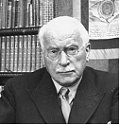 Good evening, and welcome to BBC radio 4. I’m Professor David Stephenson, professor of Dutch historical studies at Cambridge. This is the forty eighth part of our 50 episode special on the second 80 years war over Europe. Joining me for these broadcasts are fellow researchers and scholars Doctor Albert Andrews, specialist in German studies from the Berlin academy, Professor Robert Lowe, specialist in French studies at Cambridge, and a graduate student and technical assistant, Anton Thatcher. Last episode, we discussed the Dutch battles against the crusaders in the Baltic sea, and the oncoming threat over the Carpathian mountains into Transylvania.
Good evening, and welcome to BBC radio 4. I’m Professor David Stephenson, professor of Dutch historical studies at Cambridge. This is the forty eighth part of our 50 episode special on the second 80 years war over Europe. Joining me for these broadcasts are fellow researchers and scholars Doctor Albert Andrews, specialist in German studies from the Berlin academy, Professor Robert Lowe, specialist in French studies at Cambridge, and a graduate student and technical assistant, Anton Thatcher. Last episode, we discussed the Dutch battles against the crusaders in the Baltic sea, and the oncoming threat over the Carpathian mountains into Transylvania. The Polish army had managed to get their forces across the mountains by 1775, and the Dutch met them at the foot of the mountains, and set up to force them forward. The Polish had the mountains to their back and found themselves out gunned by the Dutch shells. Forced forward, the Polish winged lancers moved to lead the charge, straight into the Dutch rifle fire and rows of stakes.
The Polish army had managed to get their forces across the mountains by 1775, and the Dutch met them at the foot of the mountains, and set up to force them forward. The Polish had the mountains to their back and found themselves out gunned by the Dutch shells. Forced forward, the Polish winged lancers moved to lead the charge, straight into the Dutch rifle fire and rows of stakes.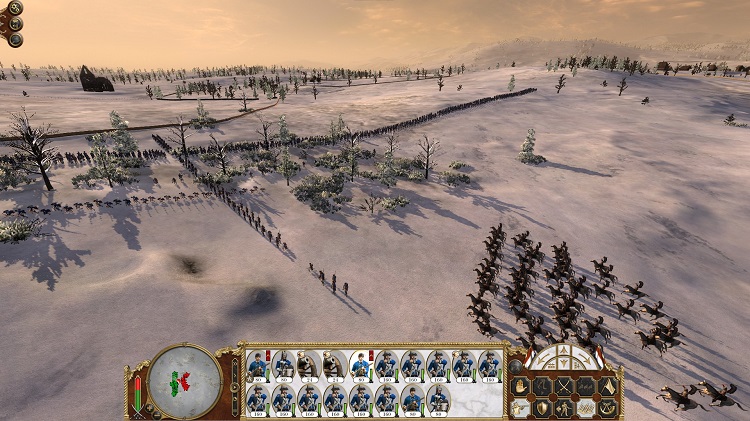
The Dutch Prepare stakes for the charge at the very last second. As the riflemen were scrambling to place their pikes, the Dutch line infantry opened fire.
 While a few light infantry were caught out of position, the Polish charge failed to cause any significant damage, losing most of their numbers to musket fire, and losing all momentum as they stalled on the Dutch barricade of sharpened stakes, causing the remainder of their line to stall. The Polish line infantry had to re-arrange, as they knew very well that it would be suicidal to charge directly into the Dutch lines without disrupting them first.
While a few light infantry were caught out of position, the Polish charge failed to cause any significant damage, losing most of their numbers to musket fire, and losing all momentum as they stalled on the Dutch barricade of sharpened stakes, causing the remainder of their line to stall. The Polish line infantry had to re-arrange, as they knew very well that it would be suicidal to charge directly into the Dutch lines without disrupting them first.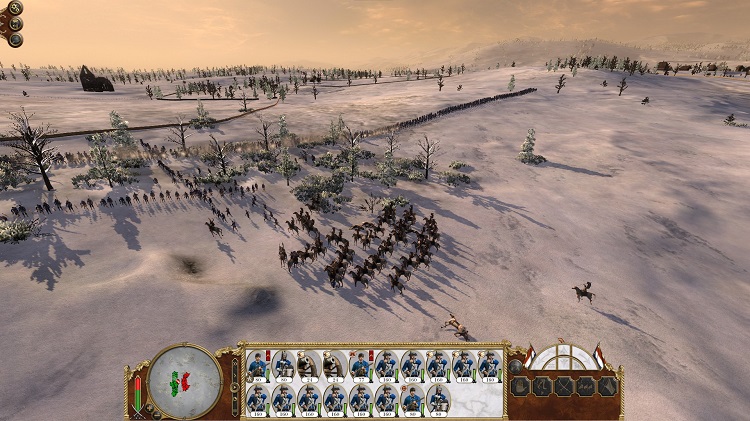
The winged hussars are lost against the Dutch line. Chivalrous warfare was well good and dead.
 Still, as the Polish army re-arranged their lines, the Dutch were bombarding them with a constant barrage of shells. Once they had moved into proper lines, they advanced on the Dutch, moving into musket range, but they lost more men from the light infantry rifles as they advanced. Unable to retaliate to the light infantry, nor to the shells, they could do nothing but press onward.
Still, as the Polish army re-arranged their lines, the Dutch were bombarding them with a constant barrage of shells. Once they had moved into proper lines, they advanced on the Dutch, moving into musket range, but they lost more men from the light infantry rifles as they advanced. Unable to retaliate to the light infantry, nor to the shells, they could do nothing but press onward. 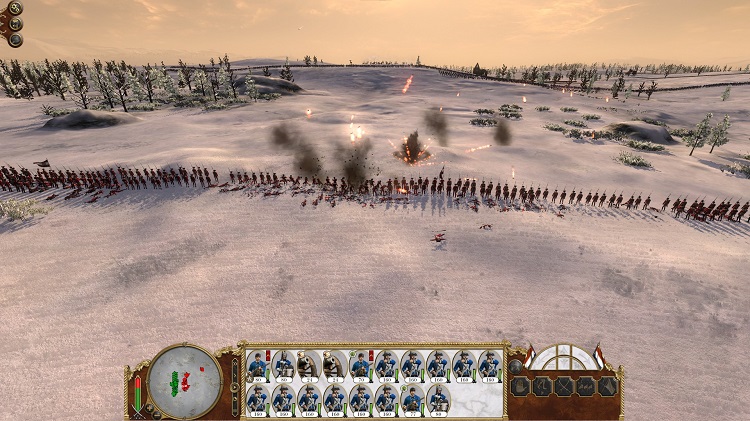
As the Polish line infantry reformed their line, the Dutch managed to crush them with artillery shells.
 Once in range however, their numbers were tragically few. Their provincial cavalry, held in reserve moved to attempt a disruption of the Dutch lines, allowing a few unreturned volleys of musket fire from the Polish, but they were intercepted by the Dutch heavy dragoons. Overwhelmed by the Dutch by sheer numbers, as their own numbers had diminished terribly, the Polish forces retreated back, trying to use a stone fence as a defensive fortification, but found their cover grossly inadequate as cover against the shelling from the Dutch artillery.
Once in range however, their numbers were tragically few. Their provincial cavalry, held in reserve moved to attempt a disruption of the Dutch lines, allowing a few unreturned volleys of musket fire from the Polish, but they were intercepted by the Dutch heavy dragoons. Overwhelmed by the Dutch by sheer numbers, as their own numbers had diminished terribly, the Polish forces retreated back, trying to use a stone fence as a defensive fortification, but found their cover grossly inadequate as cover against the shelling from the Dutch artillery.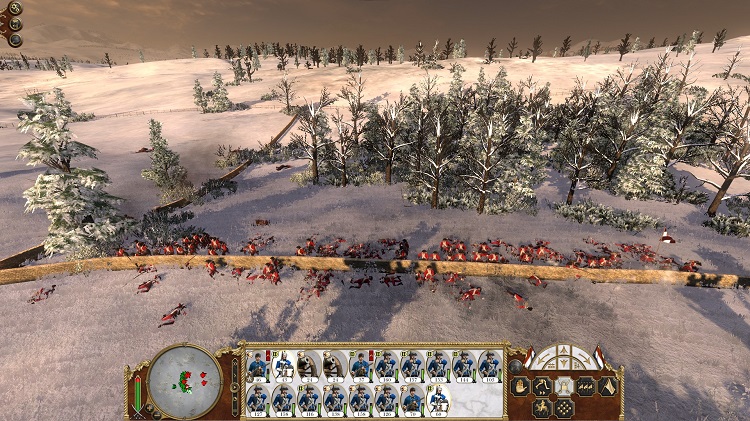
The Polish forces take a defensive position behind a fence. A maneuver that proved futile against the Dutch artillery.
 The Polish troops had to pull back more and more, and eventually moved beyond the range of the Dutch artillery. The Dutch, unwilling to wait too long, charged straight into the few remaining Polish forces, defeating the last of them in a bloody melee. Only a few cavalry managed to escape from the Transylvania garrison, retreating into the woods and mountains.
The Polish troops had to pull back more and more, and eventually moved beyond the range of the Dutch artillery. The Dutch, unwilling to wait too long, charged straight into the few remaining Polish forces, defeating the last of them in a bloody melee. Only a few cavalry managed to escape from the Transylvania garrison, retreating into the woods and mountains.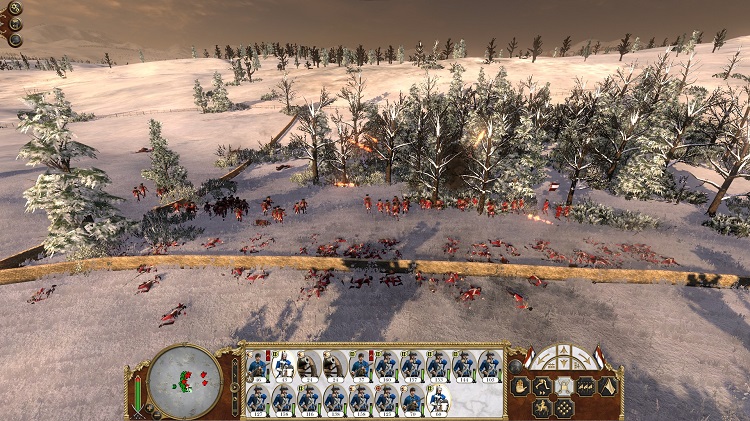
The Polish lines retreat. Their infantry could not outrun the Dutch cavalry, but a few of the Polish forces managed to evade immediate capture.
 Most of the Dutch army moved back to replenish their forces and protect their capital, but a small detachment of Dutch went through the woods trying to hunt down the last Polish forces through the dark woods. The light snow gave the Dutch an easy time tracking them, and the Polish eventually found themselves unable to advance any further, having retreated beyond the reach of their supplies, they no longer had the resources require to cross the Carpathian mountains. While they were able to live a while shooting and eating wild game from the wild woods, in the mountains, where game was scarce, and buried, frozen plants even more so, they had no hope of survival.
Most of the Dutch army moved back to replenish their forces and protect their capital, but a small detachment of Dutch went through the woods trying to hunt down the last Polish forces through the dark woods. The light snow gave the Dutch an easy time tracking them, and the Polish eventually found themselves unable to advance any further, having retreated beyond the reach of their supplies, they no longer had the resources require to cross the Carpathian mountains. While they were able to live a while shooting and eating wild game from the wild woods, in the mountains, where game was scarce, and buried, frozen plants even more so, they had no hope of survival.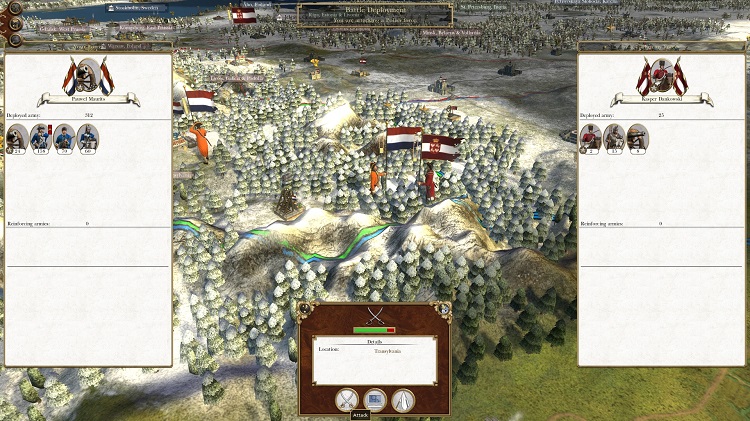
The Dutch pursue the Polish forces through the forests and mountains.
 The Polish had heard the Dutch behind them several times, and were only barely evading them. Eventually, upon reaching the mountains, they had to creep along the edge of the steeper slopes, looking for an open lane that they could charge the Dutch in, hopefully making a last stand. Their final charge, while glorious, was once again in vain, and the Polish force was gunned down before even a single lancer made it into melee.
The Polish had heard the Dutch behind them several times, and were only barely evading them. Eventually, upon reaching the mountains, they had to creep along the edge of the steeper slopes, looking for an open lane that they could charge the Dutch in, hopefully making a last stand. Their final charge, while glorious, was once again in vain, and the Polish force was gunned down before even a single lancer made it into melee.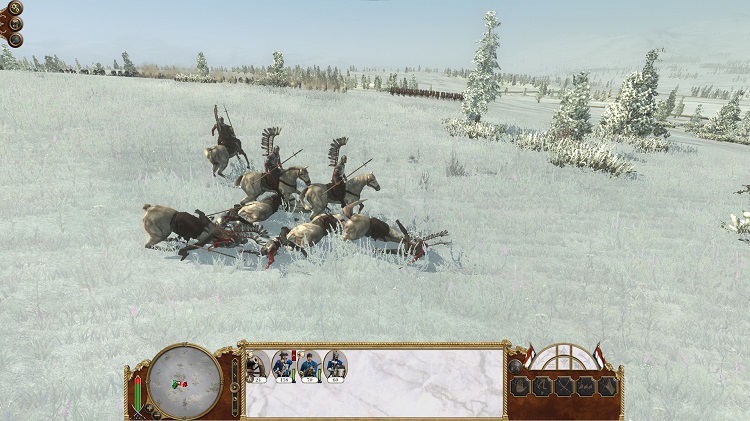
The last few Polish invaders are gunned down without mercy.
 This was the second last fight the Western Atlantic Federation would ever fight under the banner of the United Provinces. While some battles had been lost, some battles had been close run, the Dutch had, what was considered to be the longest string of unbroken victories in decades. The Federation was secure from the East Coast of North America, through half of Europe, the North Coast of Africa and all of the Sub-continent of India, and with their Prussian allies between them and the Polish aggressors, the great civilizations of the East lagging far behind. The entire world over, the Federation was known, and they were known as completely unassailable.
This was the second last fight the Western Atlantic Federation would ever fight under the banner of the United Provinces. While some battles had been lost, some battles had been close run, the Dutch had, what was considered to be the longest string of unbroken victories in decades. The Federation was secure from the East Coast of North America, through half of Europe, the North Coast of Africa and all of the Sub-continent of India, and with their Prussian allies between them and the Polish aggressors, the great civilizations of the East lagging far behind. The entire world over, the Federation was known, and they were known as completely unassailable. And the Federation was about to grow stronger. In 1776, the Dutch elected what became known as the “revolutionary cabinet”, a new set of ministers for the Republican party who were of an incredibly enlightened disposition. These men were considered the founding fathers of the Federation, as it was clear that their predecessors were merely veiled tyrants, imposing their will, or placating the public beyond the Dutch border. These new ministers wanted true democracy and reform.
And the Federation was about to grow stronger. In 1776, the Dutch elected what became known as the “revolutionary cabinet”, a new set of ministers for the Republican party who were of an incredibly enlightened disposition. These men were considered the founding fathers of the Federation, as it was clear that their predecessors were merely veiled tyrants, imposing their will, or placating the public beyond the Dutch border. These new ministers wanted true democracy and reform.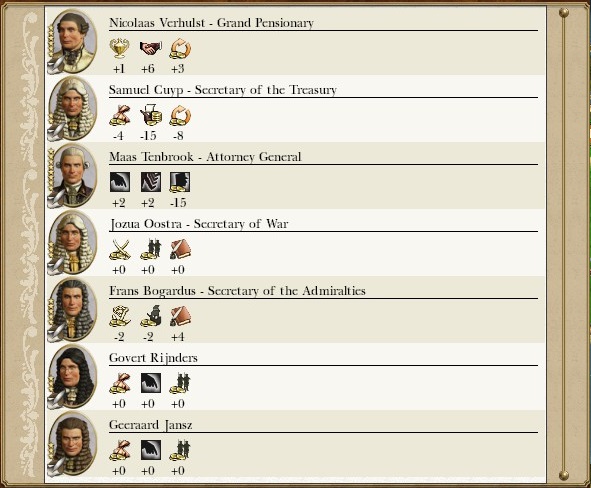
The founders of the Federation of the 1776 election. Cuyp, the pictured treasury minister was not the actual treasury minister, but was a place holder, as Hemsterhuis was away on business in Eastern Europe at the time.
 The Stadtholder was Crispijn van Heemskerk, and though he was in what was considered a traditionally war time appointment with limited peace time influence, Heemskerk managed to keep the remainder of his flighty ministers grounded without undermining their ideals. While he preferred tradition and the status quo, he did not champion everything as it was, he simply insured that the other ministers did not eliminate the good parts of the laws of the Federation. His opinion, though counter to the rest of the ministers was well respected and often heeded.
The Stadtholder was Crispijn van Heemskerk, and though he was in what was considered a traditionally war time appointment with limited peace time influence, Heemskerk managed to keep the remainder of his flighty ministers grounded without undermining their ideals. While he preferred tradition and the status quo, he did not champion everything as it was, he simply insured that the other ministers did not eliminate the good parts of the laws of the Federation. His opinion, though counter to the rest of the ministers was well respected and often heeded.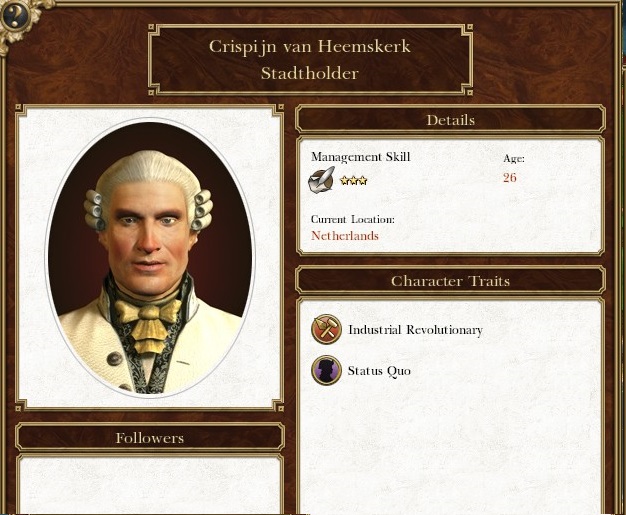
Crispijn van Heemskerk was not the leader of the Republican party, the government declaring themselves to be at peace for all intents and purposes.
 Nicolaas Verhulst was the true head of state, and by far the most talented one the Dutch had ever had. Reputedly, he worked eighteen hours a day, just to keep away from his shrewish wife, but at the same time, he was a tremendously honest man who valued integrity above all else. It was his leadership that had brought the then-new ministers together, hoping to create a true federation of independent states. His hand-picked cabinet, even including Heemskerk was one of the most carefully selected sets of ministers, completely discarding bribes, payoffs, promises and even populist sentiment to make sure the right men for the right job were elected.
Nicolaas Verhulst was the true head of state, and by far the most talented one the Dutch had ever had. Reputedly, he worked eighteen hours a day, just to keep away from his shrewish wife, but at the same time, he was a tremendously honest man who valued integrity above all else. It was his leadership that had brought the then-new ministers together, hoping to create a true federation of independent states. His hand-picked cabinet, even including Heemskerk was one of the most carefully selected sets of ministers, completely discarding bribes, payoffs, promises and even populist sentiment to make sure the right men for the right job were elected.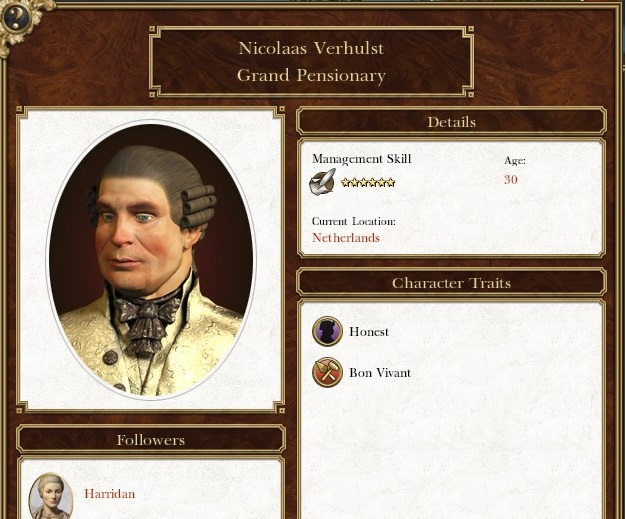
Verhulst was once attributed as saying that "All of my success at work can be attributed to a lack at home. I can thank my wife for my job and everything I have, especially that which I wish another had instead."
 His Treasury minister was Maarten Hemsterhuis, grandson of the esteemed Philologist and thinker Tiberius Hemsterhuis. Having earned his grandfather’s estate, buying it back in its entirety from his father’s debtors, Maarten was another honest man. His own brilliance in critical and rational thought was much like his forebear’s, and many of the ideas to tie together the economies, to interlink the independent states of the Federation together, binding them not only by good will, but by necessity and profit.
His Treasury minister was Maarten Hemsterhuis, grandson of the esteemed Philologist and thinker Tiberius Hemsterhuis. Having earned his grandfather’s estate, buying it back in its entirety from his father’s debtors, Maarten was another honest man. His own brilliance in critical and rational thought was much like his forebear’s, and many of the ideas to tie together the economies, to interlink the independent states of the Federation together, binding them not only by good will, but by necessity and profit.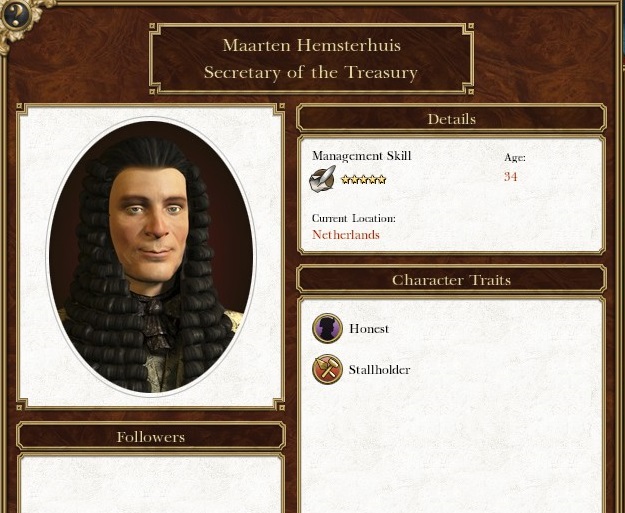
Maarten Hemsterhuis was one of the initial men to conceive of the rebirth of the federation. He was probably the most enthusiastic of the lot.
 The next and probably most well remembered was the Justice Minister was Maas Tenbrook, a very talented, but eclectic man. By all accounts, he was considered a true renaissance man, but was also prone to dramatic mood swings, some events which had become rather infamous. By the age of 27, he had owned and run an estate farm, he owned and managed five markets in Amsterdam, Rotterdam and Paris, he had been a barrister since the age of 20, becoming a judge by the age of 24. By the time he was twenty-six where Verhulst approached him to run for the position of Justice Minister for the Republicans, he reportedly said “I might as well, I’m not that busy.” despite fully managing his estate, businesses and responsibilities as a judge.
The next and probably most well remembered was the Justice Minister was Maas Tenbrook, a very talented, but eclectic man. By all accounts, he was considered a true renaissance man, but was also prone to dramatic mood swings, some events which had become rather infamous. By the age of 27, he had owned and run an estate farm, he owned and managed five markets in Amsterdam, Rotterdam and Paris, he had been a barrister since the age of 20, becoming a judge by the age of 24. By the time he was twenty-six where Verhulst approached him to run for the position of Justice Minister for the Republicans, he reportedly said “I might as well, I’m not that busy.” despite fully managing his estate, businesses and responsibilities as a judge.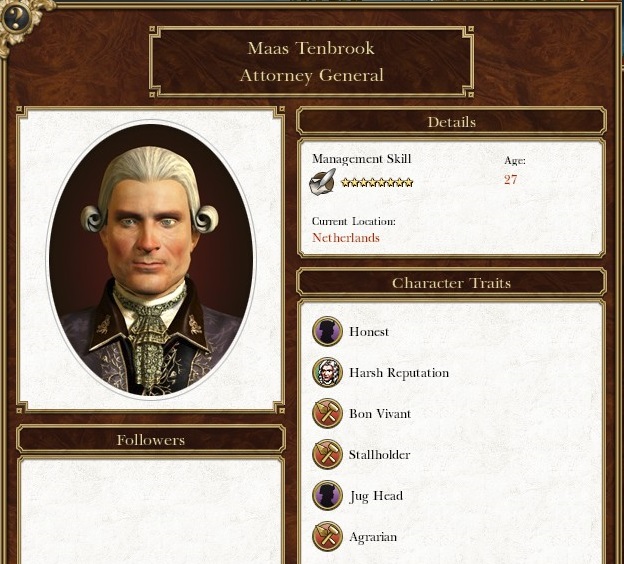
Despite all his skills, Tenbrook was a well known drunkard, often drinking on the job. This was justifiable to a degree, as he had no other time with which to drink.
 Jozua Ostra was elected the Mnister of Defence, continuing the trend of comparatively poor Defence Ministers in the Republican party. Ostra was likely the least of the ministers of the 1776 election. He had been a long time hater of Catholicism and their extremism, and had been wise enough to know the reaction to the crusade was not to counter with Protestant religious extremism and persecution, instead preaching the ideal of religious tolerance and forgiveness, but at the same time, he also said to defend against extremism with whatever weapons one could, be it with reason, piety or arms.
Jozua Ostra was elected the Mnister of Defence, continuing the trend of comparatively poor Defence Ministers in the Republican party. Ostra was likely the least of the ministers of the 1776 election. He had been a long time hater of Catholicism and their extremism, and had been wise enough to know the reaction to the crusade was not to counter with Protestant religious extremism and persecution, instead preaching the ideal of religious tolerance and forgiveness, but at the same time, he also said to defend against extremism with whatever weapons one could, be it with reason, piety or arms.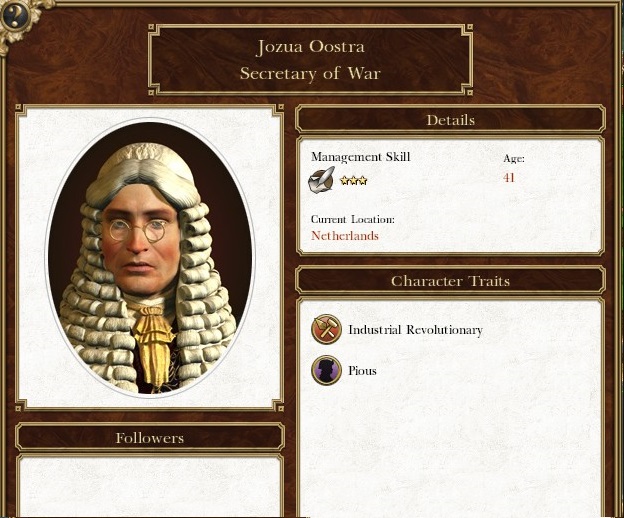
Ostra was the least of the ministers of 1776, and played little role in either the military or social reforms. It was simply that difficult for the Republicans to find a minister of defence that they could trust.
 Lastly, Frans Bogardus was the Lord Admiral of the Dutch navy. He was a competent enough man, but unlike the others, spent much of his time working on the navy itself, rather than focusing on social reform. Another countryside estate owner rather than navy man, he had to work far harder to keep the naval budget in check, which he managed to adequately do. This was in contrast with Ostra, who in all likelihood should have attempted the same to keep the army’s costs under control. However, the Lord Admiral of the Dutch navy had far more expected of him than the Defence Minister.
Lastly, Frans Bogardus was the Lord Admiral of the Dutch navy. He was a competent enough man, but unlike the others, spent much of his time working on the navy itself, rather than focusing on social reform. Another countryside estate owner rather than navy man, he had to work far harder to keep the naval budget in check, which he managed to adequately do. This was in contrast with Ostra, who in all likelihood should have attempted the same to keep the army’s costs under control. However, the Lord Admiral of the Dutch navy had far more expected of him than the Defence Minister.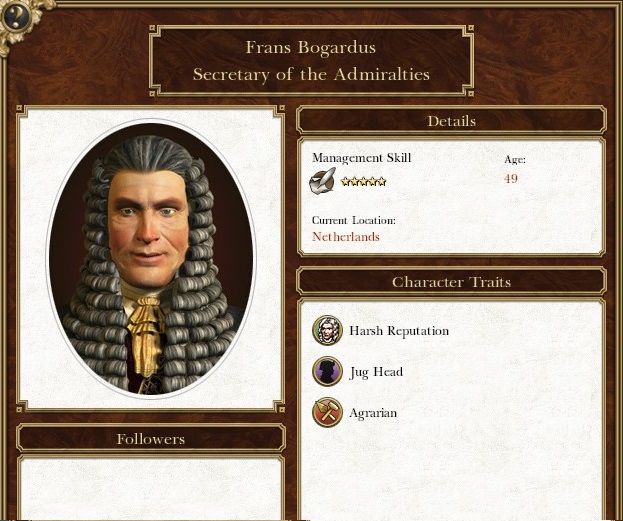
Bogardus was a hard working and capable man, but was more interested in running the navy than he was in social reform. The Republicans had fewer candidates that to pick through when it came to the army and navy, but at the very least the V.O.C. party had respectable naval trade candidates that could be dissuaded by the Republican cause.
 These were all tremendously talented men, and none of them overly neglected their duties as they negotiated with the prime ministers, presidents, kings and councils of the many nations under their control. Meetings in Paris, London, Madrid, Vienna and everywhere else within their borders saw the beginnings of a new constitution, the dissolution of long standing governments, and the creation of new democracies all began in their years in office.
These were all tremendously talented men, and none of them overly neglected their duties as they negotiated with the prime ministers, presidents, kings and councils of the many nations under their control. Meetings in Paris, London, Madrid, Vienna and everywhere else within their borders saw the beginnings of a new constitution, the dissolution of long standing governments, and the creation of new democracies all began in their years in office.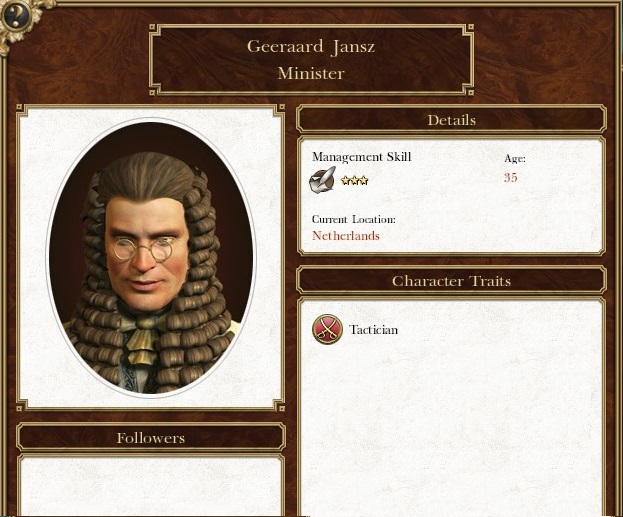
The European ministers had avoided finding suitable candidates in the Americas and in India, and as such, democracy was forestalled in India, and revolutionaries in America arose in the 1800s. The difference was that the Americans had moved from Europe to find freedom, while the people of India had a strong class system and had been used to autocratic rule.
 The Federation by 1776 was still technically run by the Stadtholder of the United Provinces, who was the de-facto head of the Federation. The new cabinet was attempting to ratify the rule of the United Provinces over the Federation to be replaced by a council of specific analogous ministers from every independent democratic state within the Federation. This council of Stadholders could elect a tyrant, which was a term borrowed directly from the old Greek use of the term rather than the modern meaning of the term, in times of emergency, but otherwise, the policy and rule of the Federation would be based around mutual cooperation between its member states.
The Federation by 1776 was still technically run by the Stadtholder of the United Provinces, who was the de-facto head of the Federation. The new cabinet was attempting to ratify the rule of the United Provinces over the Federation to be replaced by a council of specific analogous ministers from every independent democratic state within the Federation. This council of Stadholders could elect a tyrant, which was a term borrowed directly from the old Greek use of the term rather than the modern meaning of the term, in times of emergency, but otherwise, the policy and rule of the Federation would be based around mutual cooperation between its member states.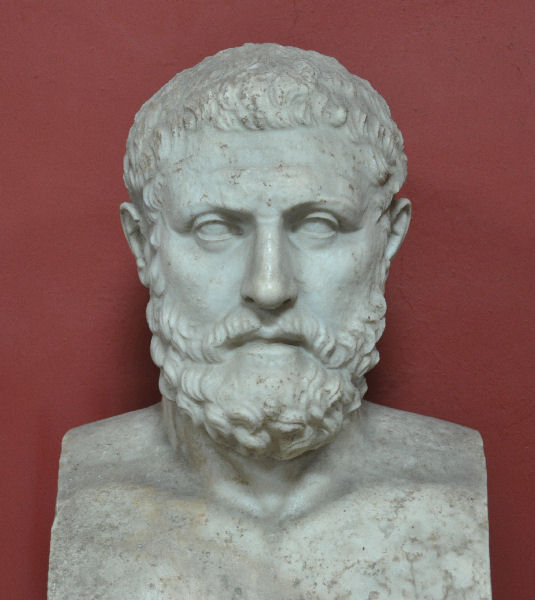
In Greece, a tyrant could arise when the people were dissatisfied with an infirm government. Often granted only rule for a life time or two, a Tyrant in power at the behest of the people could lead their nation to great power and glory. The Tyrant of Corinth managed to bring their city to greatness, and was well loved. His son, less loved was still a great ruler, and their line ended in only one generation.
 While in practice, the monarchies of the constituencies of the Dutch Empire had been neutered, in many cases, the Dutch had left them in place, as a single, un-elected monarch was relatively easy to control. In France where the Dutch were still idealistic enough to believe in the right of democracy, the monarchy had been abolished, but otherwise, many monarchies remained intact. Especially the weaker European states.
While in practice, the monarchies of the constituencies of the Dutch Empire had been neutered, in many cases, the Dutch had left them in place, as a single, un-elected monarch was relatively easy to control. In France where the Dutch were still idealistic enough to believe in the right of democracy, the monarchy had been abolished, but otherwise, many monarchies remained intact. Especially the weaker European states. Now however, the Dutch were essentially forcing these states to convert to democracy, lest they find themselves entirely without power in the Federation. For France and Britain, this change came easily, and very soon after, nations began to form democratic governments. Transition was slow, and with the Dutch and their tremendous armies preventing violent retribution from the monarchy, and violent revolution from the populace, many states adopted a constitutional monarchy. Spain, Cologne and Munich however, became true democracies, demoting the monarchy to members of the nobility.
Now however, the Dutch were essentially forcing these states to convert to democracy, lest they find themselves entirely without power in the Federation. For France and Britain, this change came easily, and very soon after, nations began to form democratic governments. Transition was slow, and with the Dutch and their tremendous armies preventing violent retribution from the monarchy, and violent revolution from the populace, many states adopted a constitutional monarchy. Spain, Cologne and Munich however, became true democracies, demoting the monarchy to members of the nobility.
The new flag of Spain after the rise of democracy.
 In Portugal, which had joined willingly under terms granting them perpetual influence in the Federation, the monarchy remained in power. They also remained in Genoa, which was essentially only in the Federation under extreme duress imposed on them by the Dutch. In the Vatican, they subverted the intent of the rule by stating only cardinals could run for government within Rome, but as they were a city state of a fairly small size, their opinion would be constrained regardless.
In Portugal, which had joined willingly under terms granting them perpetual influence in the Federation, the monarchy remained in power. They also remained in Genoa, which was essentially only in the Federation under extreme duress imposed on them by the Dutch. In the Vatican, they subverted the intent of the rule by stating only cardinals could run for government within Rome, but as they were a city state of a fairly small size, their opinion would be constrained regardless.
The papal election and "presidential" election always occurred at the same time, and the pope was always simultaneously elected "president for life" and pope.
 Strangely, though not a member of the Federation, Sweden’s King Gustaf the fifth abdicated in favour of a constitutional monarchy. The people of Scandinavia had a long history of believing themselves free men, and Gustaf recognized that he would not be able to hold his title long with liberty and democracy becoming the norm rather than exception in Europe.
Strangely, though not a member of the Federation, Sweden’s King Gustaf the fifth abdicated in favour of a constitutional monarchy. The people of Scandinavia had a long history of believing themselves free men, and Gustaf recognized that he would not be able to hold his title long with liberty and democracy becoming the norm rather than exception in Europe.
The Swedish kingdom adopts a parliament and declares itself a republic.
 This single decade would define our world as we now know it. The Allies of the 1900s opposing the communist and Imperial rule of the day were defined around solidarity built by these founding fathers of the Federation, and around the ideal of democracy, liberty and freedom. At the same time however, this was the single action which would lead to the fall of the Dutch Empire.
This single decade would define our world as we now know it. The Allies of the 1900s opposing the communist and Imperial rule of the day were defined around solidarity built by these founding fathers of the Federation, and around the ideal of democracy, liberty and freedom. At the same time however, this was the single action which would lead to the fall of the Dutch Empire.
The actions of the Atlantic Federation and their founding father in 1776 would provide the basis for the dividing line of nations for the 1900s.
 The Dutch citizens themselves were outraged by the state of things by the 1780s, and the new cabinet with their high ideals had lowered the station of the Dutch to be on par with the rest of the Federation, whereas before they could consider themselves superior. The Dutch of Amsterdam were also sickened by the sheer amount of trade profit which was pulled from the coffers of the Dutch to finance foreign businesses.
The Dutch citizens themselves were outraged by the state of things by the 1780s, and the new cabinet with their high ideals had lowered the station of the Dutch to be on par with the rest of the Federation, whereas before they could consider themselves superior. The Dutch of Amsterdam were also sickened by the sheer amount of trade profit which was pulled from the coffers of the Dutch to finance foreign businesses.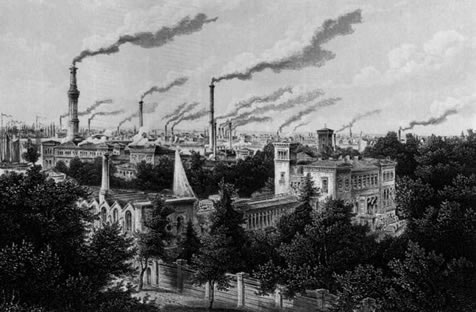
Money flew from Dutch coffers to the benefit of millions of others. These German factories had cost millions of guilders of Dutch trade revenue.
 While the world around the Dutch had come to embrace their republican ideals, the Orange party, and hundreds of thousands of Dutch had begun to rail against them. The Dutch Republic would not last much longer.
While the world around the Dutch had come to embrace their republican ideals, the Orange party, and hundreds of thousands of Dutch had begun to rail against them. The Dutch Republic would not last much longer.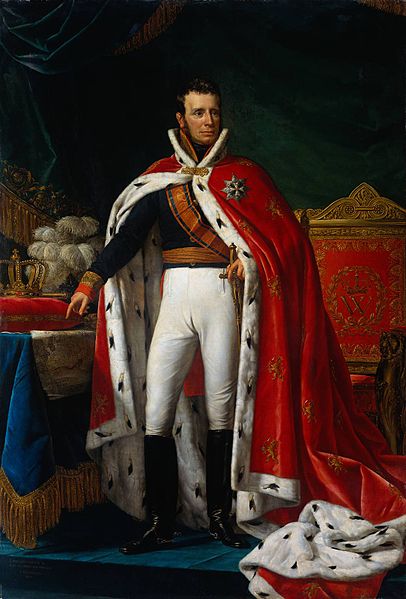
The well known portrait of William the first, a direct descendant of William III.
 Next, we will be presenting you our best recipe for spring lamb followed by world news. If you want news of the current war in the Middle East please channel in to BBC radio 1. David Stephenson will be presenting more on the 80 years war in 3 days.
Next, we will be presenting you our best recipe for spring lamb followed by world news. If you want news of the current war in the Middle East please channel in to BBC radio 1. David Stephenson will be presenting more on the 80 years war in 3 days.